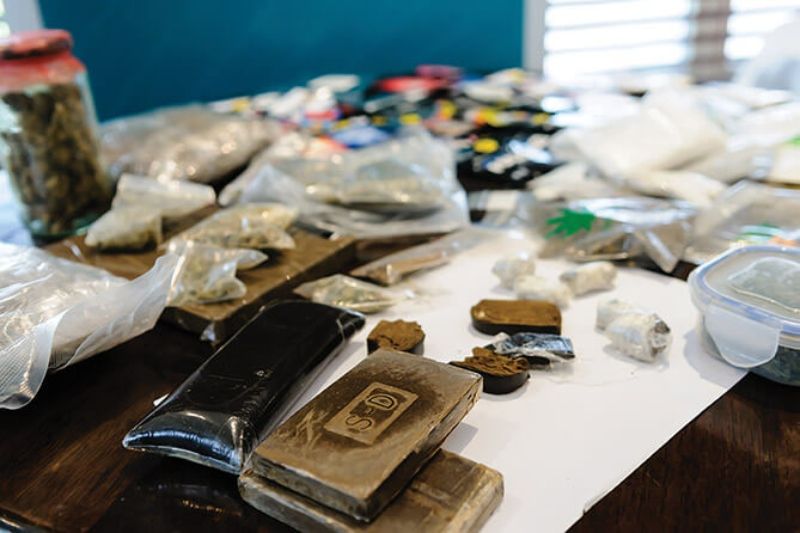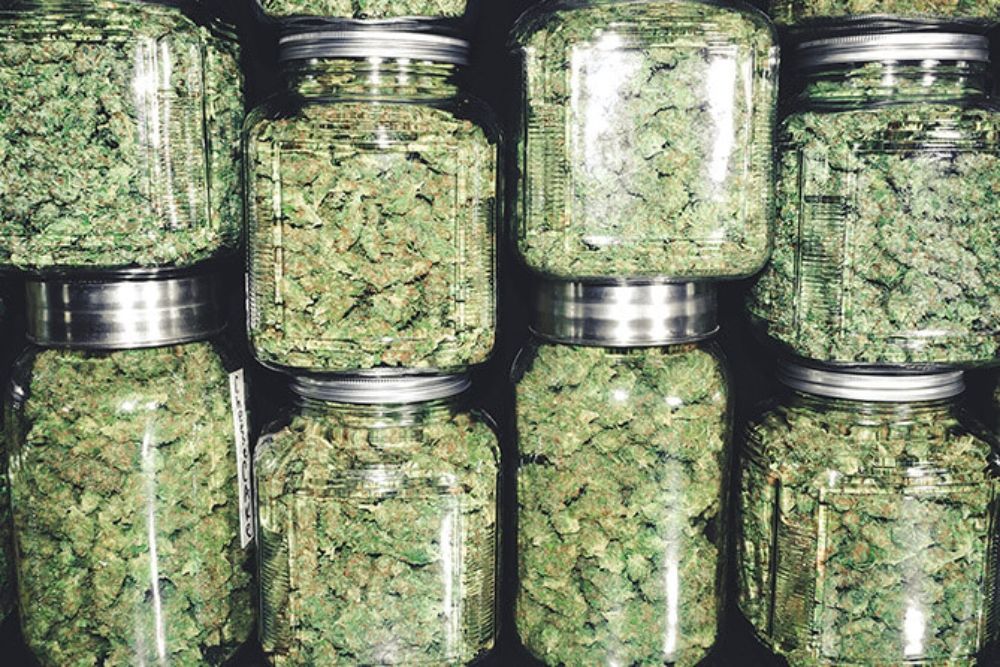(This story appears in the September issue of Marijuana Business Magazine.)
Cannabis businesses have long struggled with the excessive packaging their products are required to use, employing extra layers of plastic and paper to ensure that flower or vape products are childproof and don’t fall into the wrong hands.
But that struggle might be nearing its end: New plant-based paper and plastic packaging options are coming to market at a price point that’s comparable to conventional packaging. That’s all thanks to the ingenuity of a few innovative minds that are working to use hemp and marijuana waste to make cannabis bio-circular. In other words, the plants come from the earth, and their leftover waste can be used to create environmentally friendly products such as hemp paper that can be recycled multiple times rather than going straight to a landfill.
“We are selling this medicine, these healing products, but we’re selling it in one of the most irresponsible ways possible. So the cannabis industry, in particular, has gotten to the point that it is begging for sustainable packaging solutions,” Halverson said.
Timing is everything
The economic shock caused by the coronavirus pandemic revealed the weaknesses in the global supply chain. It’s also created a serendipitous moment for North America’s green packaging companies, and executives say there are four reasons why now is the right time for cannabis brands to switch to green solutions:
Reducing waste while increasing cannabis use and profits: Long-desired sustainable packaging alternatives that incorporate cannabis have been elusive because of the legality of hemp and marijuana. Also, supply-chain hurdles stand in the way of companies converting waste to usable raw material.
Stopping waste pollution: Cannabis destruction has traditionally been required during waste disposal. Consequently, much of this biodegradable material has been thrown into landfills, adding another financial and environmental burden to cannabis cultivators and processors. Instead, growers and processors could give their waste to entrepreneurs who can salvage it for other uses and eliminate two problems at once—all while adopting sustainable packaging.
Bio-circular requirements are the future: Using the waste that is readily available to create environmentally friendly products such as plant-based plastic bottles—versus those produced from fossil fuels—can make the industry bio-circular and position companies for the years ahead.
Such a change is bound to be part of the next green revolution, according to Tarek Moharram, founder of London, Ontario-based Moharram Ventures and bioplastics firm True Green Plastic.
“We are asking our regulators to build in a requirement to say, ‘If you, as an industry, have a bio-circular opportunity, you need to be taking it or be seriously exploring it,’” he said. “Bio-circular is going to be the future for consumer-packaged goods, because ultimately we’re making things with carbon.”
It also makes good financial sense. In the cannabis industry, biomass is 80% of what comes out of the ground, and it isn’t being used, Moharram said.
Leaders of publicly traded cannabis companies “have a fiduciary duty to their shareholders, and almost 90% of what’s being grown isn’t having value extracted from it,” he said.
Consumers care: Brands need to communicate with customers about their values, then demonstrate those values through action, according to Moharram.
“Consumers are really focusing on triple-bottom-line organizations,” Moharram added. “People care about the footprint of the industry. When you are speaking to the consumer about and demonstrating your values, that’s what builds long-term consumer relationships and lifetime customers.”
Got paper?
Industry needs can often lead to opportunities. Take the case of Tiny ePaper.
Halverson started the company in November 2017 after a conversation with a cannabis industry colleague revealed that the industry didn’t have access to 100% hemp paper.
“My original goal was to get them to switch, and then the cannabis industry gets to be a model for every other industry in showing that we can actually band together and make really smart, responsible decisions and change an entire industry and be a model for everybody else,” Halverson said.
But she quickly found that a lack of pulpers and paper mills were willing to work with hemp, as the crop at the time was still illegal at the federal level. And those that were willing to do business generally weren’t close to California.
“First of all, finding anybody to believe that I could get to 100% hemp paper on a commercial, scalable basis was a chore in itself,” Halverson said.
After hemp was legalized with the passage of the 2018 Farm Bill, Halverson said she saw a greater willingness among companies to learn about hemp paper and process it. But the supply chain remains a struggle because there is a shortage of processors and pulpers, so most of her cost goes to shipping raw material out of state and back, then shipping it to other manufacturers to make the paper. Ultimately, it would be ideal to have an extractor, raw material processor, paper mill and printer in geographical “silos” in the West, Midwest and East, Halverson said.
Hemp paper is notoriously strong compared to tree paper, Halverson said, and it can be recycled seven to eight times as opposed to three or four times for tree paper. Over the past several months, Halverson has been busy proving these concepts on the social media network LinkedIn.
Using the same hemp paper she uses for business cards, Halverson reverse-engineered standard die-cut packaging from cannabis—including childproof packaging—to packaged beverages including sparkling water, beer and wine.
“My purpose was to show that you can make hemp paper function in any part of the manufacturing process,” Halverson said. “I’m proving that the same glue and the same amount of glue work. … They might have to add a certain amount of pressure onto the die-cut machine to cut through the paper, but every time they put in a different stock, they have to recalibrate the machine for that anyway.”
Halverson said the LinkedIn posts have generated so much interest that she has signed several letters of intent and has other potential customers ready to sign once she is up and running. In July, Halverson estimated she would be ready to take preorders in the next 30 to 60 days, once her final pulper and paper mill-vetting process was complete and she could get paper to her selected product manufacturers.
“This is helping me build some data points so I make sure that I make enough paper,” Halverson said. “I’m showing the world that this doesn’t have to be centered around cannabis. I’m (using hashtags for) beverages and other industries, trying to open up people’s minds right now to the possibilities of the hemp plant. That’s also given me more demand and created more insurance.”
Halverson said she’s also looking into additional intellectual property using organic adhesions and vegetable-based inks on her packaging, because she is adamant no harmful chemicals touch her products.
“I don’t use any chemicals or any substances that I can’t put in my body; if I can’t drink it, it doesn’t go on my product,” Halverson said.
As demand for plant-based packaging ramps up, it’s likely there will need to be more cannabis waste to repurpose. Despite regulatory pressures, the unprecedented growth of the cannabis market worldwide shows there will be ample supply for now, according to Halverson, who sources all the hemp waste for her paper from extraction firms and hemp growers. While setting up her business in North America, she has made contacts in other parts of the world that are ready to provide waste and help her develop the international supply chain for hemp paper.
The next step for Halverson is taking the crop full circle and creating a living soil made with hemp and paper waste for farmers to boost their yields—a project that’s already in the works with a private company, she said.
Plant-based plastics
According to the U.S. Natural Resources Defense Fund, humans worldwide produce 300 million tons of plastic each year, half of which is for single-use items—a figure nearly equivalent to the weight of the entire human population. Single-use plastics include packaging, bottles, wrappers, straws and bags, which are often disposed of immediately after use.
Polyethylene terephthalate, which is one of the most commonly recycled plastics, can be recycled into products from polyester to car parts, although 91% of all plastic isn’t recycled at all. Instead, that waste ends up in landfills—or, worse yet, discarded in the environment.
Currently, 99% of plastic is derived from fossil fuels, which means the market possibilities for plant-based alternatives are endless. Two new companies in the cannabis space are aiming to bring products to market that will make a difference.
Knot Plastic, a manufacturer based in Saco, Maine, set out in February to create safe, nonplastic alternative packaging products.
When the COVID-19 pandemic hit, Knot Plastic co-founders Ry Russell and Michael Osborne, an engineer, had already done all the tooling and were ready to manufacture cannabis pre-roll containers. But when manufacturers were shut down, they quickly pivoted to develop the plant-based Knot Plastic bag, having quarantined themselves in a factory to contain any potential spread of the coronavirus.
The team started with ethanol because of the abundant corn supply and because they thought there was a shortage of hemp, making the raw material cost-prohibitive. But when they learned about the oversupply of hemp biomass from the 2019 crop, Russell called some local farmers and started experimenting.
“We added 15% of industrial hemp, and we nailed that. Now, we’re testing 25%,” Russell said. “We’re testing to see how much hemp we can add to our polymers and start that transition now.
“Even if it’s not permanent, we want to include hemp in our cannabis packaging that we’re launching this fall. If next year the economics don’t make sense, we still have a consistent supply of non-GMO corn to make our polymers and our high-density plastics. We’re not a hemp or corn company—we’re a plant-based plastics company.”
Knot Plastic can currently supply 15 million bags per month and has ordered two more machines to produce the bags, which will at least double production.
Meeting consumer demand
The interaction with hemp farmers while sourcing material for the Knot Plastic bags led to a second product—biodegradable zip ties. Because hemp growers are required to label every plant for traceability, one farmer said he was spending up to $11,000 per year on zip ties. After some research into the market, Russell submitted the tooling, and the product debuted this summer.
Knot Plastic also released a hemp-based urine sample cup, demonstrating the ability to create plant-based packaging for the medical-supply market. With this success, Russell and partners are adding larger percentages of hemp to their products, and they hope to integrate hemp into the cannabis packaging—a pre-roll tube and 19-dram, child-resistant pop-top container—that drops this fall.
“We have to scale into each SKU, so we’re going to introduce the 19-dram, make those relationships and then just listen to the feedback on what other sizes are needed,” Russell said. “The market will tell us where we need to be.”
Initially, Knot Plastic will be able to produce 10 million units per month and has ordered machines so production can ramp up with demand, Russell said.
“For us, it was really important that we set up our supply chain. We are way more self-reliant on toolmaking and production,” Russell said, referring to how COVID-19 brought much of the international manufacturing sector to a standstill. “Where we’ve got a unique opportunity for future products is that it’s never going to take us nine months again from concept to production. We should be able to go from product development to a finished good in about 90 days.”
That commitment isn’t just competitive—Russell wants to declare war on the fossil-fuels market and replace those products with plant-based alternatives.
“We need to be able to be the fastest rather than allowing time for less ethical solutions to come to market,” Russell said. “Ocean-recycled plastic just restarts this entire process all over again; we hurt somebody when we melt it down. We hurt somebody when we have no idea where that product goes. So Knot Plastic has got to be faster and more efficient than anybody else to deliver truly not-plastic products. That’s my KPI.”
Customized biodegradability
In Canada, Moharram Ventures’ Truly Green Plastic effort—in partnership with a team of researchers from Lambton College in Sarnia, Ontario—has created a biodegradable plastic polymer from cannabis waste that is sourced from Canadian license holders.
Moharram aims to offer pelletized, cannabis-based plastic polymers to manufacturers. It’s the same form in which most petroleum-based plastics are provided, ensuring minimal disruption to the manufacturing process.
The company is currently self-funded and not making plastic at a commercial scale, but at press time, Moharram was spearheading a capital raise to build a facility and begin production.
Using a bacterial process, Moharram and his research partners converted cellulose into a thin, biodegradable film that can be used on its own or blended with other elements to create unique composites. The film is designed to break down naturally when exposed to organic elements in the environment and can ultimately be tailored to break down in hours or within a year, according to Moharram.
The goal is to use the process to turn cannabis waste into personal protective equipment, medical transdermal patches and food packaging.
“We want the polymers to be narrowly tailored to what their purpose is—that’s the future of where we’re going with the polymer space, certainly single-use plastic,” Moharram said.
He points to the example of plastic bags used to pick up dog waste and how they do not naturally decompose.
“That’s the future of this green change in our consumer-activity patterns. It’s OK to have plastic, but it’s much better if it’s biodegradable and it’s suited to its purpose and doesn’t last longer than it’s needed,” Moharram said.
According to Moharram, plastic wrap used to package cucumbers and plastic protectors placed over the screens of electronic devices are other examples of needless waste that is immediately discarded but lasts longer in landfills than necessary. On the other hand, he noted, products must be usable as long as they’re needed.
“Ultimately, we want to be cautious about just totally jumping off the deep end in the other direction. Look at paper straws: We know they don’t work so well,” Moharram said. “If we can offer a Truly Green Plastic solution to have it biodegrade five days from when it was submerged in liquid, great. It doesn’t have to last forever—perhaps 15% longer than you need it—but it should last more than 15 minutes.”







